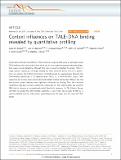Context influences on TALE–DNA binding revealed by quantitative profiling
Author(s)
Rogers, Julia M.; Reyon, Deepak; Sander, Jeffry D.; Kellis, Manolis; Joung, J. Keith; Bulyk, Martha L.; Barrera, Luis Alberto; ... Show more Show less
DownloadRogers-2015-Context influences.pdf (538.3Kb)
PUBLISHER_CC
Publisher with Creative Commons License
Creative Commons Attribution
Terms of use
Metadata
Show full item recordAbstract
Transcription activator-like effector (TALE) proteins recognize DNA using a seemingly simple DNA-binding code, which makes them attractive for use in genome engineering technologies that require precise targeting. Although this code is used successfully to design TALEs to target specific sequences, off-target binding has been observed and is difficult to predict. Here we explore TALE–DNA interactions comprehensively by quantitatively assaying the DNA-binding specificities of 21 representative TALEs to ~5,000–20,000 unique DNA sequences per protein using custom-designed protein-binding microarrays (PBMs). We find that protein context features exert significant influences on binding. Thus, the canonical recognition code does not fully capture the complexity of TALE–DNA binding. We used the PBM data to develop a computational model, Specificity Inference For TAL-Effector Design (SIFTED), to predict the DNA-binding specificity of any TALE. We provide SIFTED as a publicly available web tool that predicts potential genomic off-target sites for improved TALE design.
Date issued
2015-06Department
Harvard University--MIT Division of Health Sciences and Technology; Massachusetts Institute of Technology. Computer Science and Artificial Intelligence Laboratory; Massachusetts Institute of Technology. Department of Electrical Engineering and Computer ScienceJournal
Nature Communications
Publisher
Nature Publishing Group
Citation
Rogers, Julia M., Luis A. Barrera, Deepak Reyon, Jeffry D. Sander, Manolis Kellis, J Keith Joung, and Martha L. Bulyk. “Context Influences on TALE–DNA Binding Revealed by Quantitative Profiling.” Nat Comms 6 (June 11, 2015): 7440. © 2015 Macmillan Publishers Limited
Version: Final published version
ISSN
2041-1723